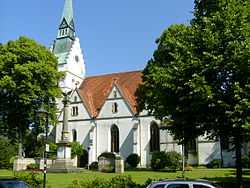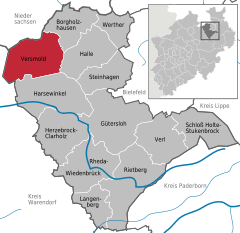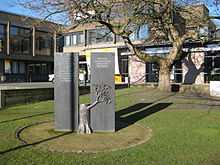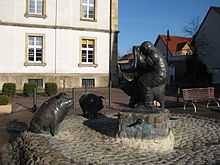Versmold
| Versmold | |||
|---|---|---|---|
 | |||
| |||
 Versmold | |||
Location of Versmold within Gütersloh district 
 | |||
| Coordinates: 52°02′37″N 08°09′00″E / 52.04361°N 8.15000°ECoordinates: 52°02′37″N 08°09′00″E / 52.04361°N 8.15000°E | |||
| Country | Germany | ||
| State | North Rhine-Westphalia | ||
| Admin. region | Detmold | ||
| District | Gütersloh | ||
| Subdivisions | 6 | ||
| Government | |||
| • Mayor | Thorsten Klute (SPD) | ||
| Area | |||
| • Total | 84.81 km2 (32.75 sq mi) | ||
| Elevation | 65–87 m (Bad rounding hereFormatting error: invalid input when rounding ft) | ||
| Population (2012-12-31)[1] | |||
| • Total | 20,817 | ||
| • Density | 250/km2 (640/sq mi) | ||
| Time zone | CET/CEST (UTC+1/+2) | ||
| Postal codes | 33775 | ||
| Dialling codes | 0 54 23 | ||
| Vehicle registration | GT | ||
| Website | www.versmold.de | ||
Versmold is a town in Gütersloh District in the German state of North Rhine-Westphalia. It is located some 30 km west of Bielefeld.
History
In 1096 Versmold was first mentioned in a document, and is thus one of the oldest known settlements in the region. The name "-mold" alludes to "melle", "mal" a location of a court.
Situated between the bishoprics Osnabrück and Münster, the possession of Versmold was disputed for a long time in the high Middle Ages. The population tried to protect themselves as good as they could. The St. Petri church was built as a "Wehrkirche" for defense.
After 1277, when the counts of Ravensberg acquired possession of the region of Versmold, the siutation changed. Versmold formed the western most town of the historic county of Ravensberg with its capital Bielefeld. After the War of the Jülich Succession in 1614 the county came to Brandenburg and later to Prussia. Within predominantly Catholic Westphalia, the county of Ravensberg became Protestant. In 1719 the King of Prussia granted city rights in order to raise more taxes.
Until the late nineteenth century the county was poor and subsistence oriented. Only the linen production is worthy to note. Between 1650 to 1914, during the harvest season many people who did not found any other income in the county sought for an additional income in Holland. They were called 'Hollandgänger'. For the same reasons the city saw an extensive emigration to America, especially during the 1850s and 1860s, because of the weak economic situation. Many of them settled in the Midwest, especially in Missouri and Texas.
After 1871 when the newly united Germany built up a navy, the linen-industry became prosperous by providing sailing canvases. Most notably engaged in the linen-industry was the family Delius. In the 1820s some members of the family emigrated to Mexico where they established a flourishing import-export business. By the late nineteenth century they had representations in Berlin and Hamburg.
Since World War II the city flourished mainly due to its meat-processing factories, which had grown out of the rural art of sausage-making. After WWII larger companies and factories sold what they could not process often to small one-man meat dealers and small scale butchers. They in turn sold it on weekly markets mostly in the underprovisioned but prosperous industrial region of the Ruhrgebiet. Sometimes they created also their own specialities. This profession was called Kleinfleischhaendler (small scale meat dealer) which became typical for Versmold in the 1950s and 1960s. This peculiarity faded out during the 1980s and 1990s. Supply industries evolved around meat processing. Several forwarding companies specialized in food transportation. The largest of them, Kraftverkehr Nagel operates today in many countries. Its head quarter remains in Versmold.
The industry diversified after World War II. A major factory for bottle crown caps Bruenninghaus developed out of a factory for bicycle saddles, called Metall und Leder. It is still one of the main industries in Versmold. In the late 1940s just neighboring the saddle factory a local entrepreneur Gustav Baumhoefer established a shoe factory producing under the brand name Ravensberger Schuhe. The company closed in 1982 due to shifts in the world marked for shoes and the lack of competitiveness. In 1949 a wood processing factory producing window and door frames was opened, the Wirus Werke; but it also shut down during the 1980s. Its mother company resides still in Guetersloh.
Memorials
As in many small German towns part of its modern history had become a visible expression within the cityscape. A small unimposing stone cross of the eleventh century in the middle of a traffic circle had been once the sign for a medieval rural court.
A bronze medallion of Otto von Bismarck, a bronze bust of the German emperor Wilhelm I and his popular but short reigning successor Friedrich III were signs of the patriotism and the Bismarck-cult in the 1880s and the early 1900s. In 1909, the Bismarck pyramid was built up with natural granite stoneblocks centrally located in city's park (Stadtpark) and topped by a Prussian eagle. The latter became a victim of vandalism after WWI. In 1942, the bust of the liberal, but among the Nazis unpopular, emperor Friedrich III was melted down. Wilhelm's bust was transferred into the Stadtpark, which had become a haven for unwanted history. The bust is since more than 30 years damaged by vandalism and hard to find, hidden behind bushes. The Bismarck-medallion was removed from its central location and attached to one red granite stone block which was leisurely placed under trees in a distance but still visible from the walkway.

The names of the fallen soldiers of World War I from the municipality of Versmold are remembered on a monument in front of the Protestant St. Petri church, a column crowned by an eagle (see image). The victims of World War II, without providing their names, found in the sixties a place of commemoration in a small park behind the town hall in the form of bronze crosses and a bronze flambeaux. This small park with a bronze lecturn is staged for official ceremonies.

In September 2000, a memorial for the murdered Jewish population was set up in the middle of the town, very prominently, right in front of the town hall. It lists the names of the local victims of the Holocaust. Most prominent among them figures the family Spiegel. The design was developed by a two students and their teacher from the local highschool.[2] The historian Reinhart Koselleck cited the difference in the naming of the murdered Jewish citizens and the anonymity of memory for the fallen soldiers and immediate victims of World War II in Versmold as example of how the Germans deal with their recent history in the collective memory.[3]
The new blossoming of the town after World War II is visualized by a bronze statue of a worker with a pig passing under his right leg. He holds in both hands a stick with six sausages dangling from it. It stands across the Protestant church on a modern (1980s) Italian style 'piazza'. This statue is locally known as "Schweinebrunnen" (pig's fountain)".

Communities forming the town
- Versmold
- Bockhorst
- Hesselteich
- Loxten
- Oesterweg
- Peckeloh
Local Newspapers
- Haller Kreisblatt (with a daily page on local events). Oldest traditional newspaper for the western part of the county of Ravensberg.
- Westfalenblatt, with a daily local page Versmolder Anzeiger
Literature
- Vinke, Wilhelm, Heimatgeschichte der Stadt Versmold und Umgebung, Self-published, 1924
- Vinke, Wilhelm, Versmold – Ein Volks- und Heimatbuch, Amtsverwaltung, 1962
- Vinke, Wilhelm, 250 Jahre Stadt Versmold 1719–1969, Stadt Versmold, 1969
- Westheider, Rolf, Versmold – Eine Stadt auf dem Weg ins 20.Jahrhundert, Verlag für Regionalgeschichte, 1994; ISBN 3-89534-276-9
- Westheider, Rolf, 900 Jahre kirchliches Leben in Versmold 1096–1996, Verlag für Regionalgeschichte, 1996; ISBN 3-89534-165-7
- Westheider, Rolf, Arbeit und Freizeit in Versmold, Erfurt:Suttan, 2001; OSBN 3-89702-314-8
- Beckmann, Volker, Jüdische Bürger im Amt Versmold – Deutsch-jüdische Geschichte im westlichen Ravensberger Land, Verlag für Regionalgeschichte, 1998; ISBN 3-89534-248-3
- Heimatverein Versmold e.V., Das Versmolder Bürgerstättenbuch,2nd ed., March 2006.
References
- ↑ "Amtliche Bevölkerungszahlen". Landesbetrieb Information und Technik NRW (in German). 31 July 2013.
- ↑ Anonymous. "CJD Versmold Aktionen". Retrieved 25 November 2012.
- ↑ Koselleck, Reinhart. "Ich war weder Opfer noch befreit". Berliner Zeitung 2005-05-07. Retrieved 25 November 2012.
External links
| |||||||

